#edward hooper
Text
European paintings here. Other art polls in my 'art' tags.
The paintings are right below :








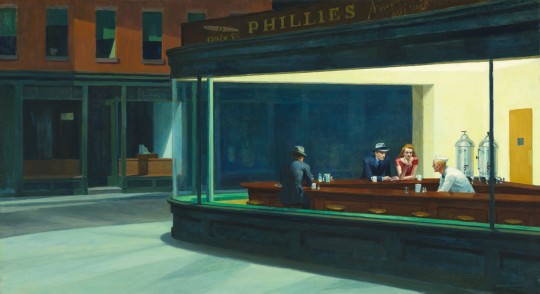

#polls#art#paintings#whistler's mother#james whistler#number 5#jackson pollock#black iris#georgia o'keeffe#untitled 1982#jean michel basquiat#american gothic#grant wood#christina's world#andrew wyeth#nighthawks#edward hooper#campbell's soup#andy warhol#drowning girl#roy lichtenstein#madame x#john singer sargent
17 notes
·
View notes
Photo

No restaurante
“Sensivelmente a meio da refeição, as coisas parecem ficar piores. Blue deteta um olhar de grande tristeza no rosto de Black, e de repente e mulher parece estar a chorar.”
Paul Auster, “A Trilogia de Nova Iorque”; pintura de Edward Hopper.
2 notes
·
View notes
Text
OFFICE AT NIGHT, EDWARD HOPPER
1940 – Social Realism – 56,4 x 63,8 cm
No “Office at Night”, a luz vem de três fontes: de uma luz acima, de uma lâmpada, na mesa do homem, que emite uma porção intensa de luz e de uma luz da rua que brilha na janela aberta, do lado direito. Hopper afirmou que a mistura da luz do teto e da luz do exterior criou dificuldades técnicas, visto que ela requereu que ele utilizasse diferentes sombras de…

View On WordPress
0 notes
Text
resolving all oppenheimer vs barbie debates by telling people to watch asteroid city instead
#yes this is edward norton voice acting for the simpson’s#yes i spiraled last night and watched both episodes he’s in#doing well!#edward norton#the simpson’s#reverend elijah hooper#oppenheimer#barbie#asteroid city#barbenheimer#post!
88 notes
·
View notes
Photo

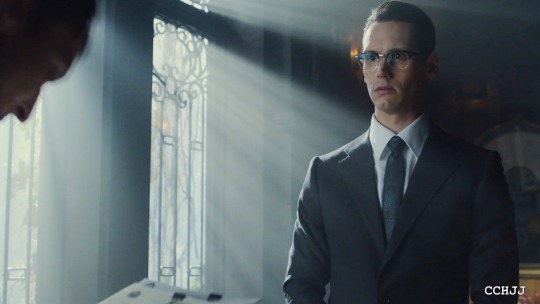
"ʏᴏᴜ ʟᴏᴏᴋ ꜱᴀᴅ ᴡʜᴇɴ ʏᴏᴜ ᴛʜɪɴᴋ ʜᴇ ᴄᴀɴ'ᴛ ꜱᴇᴇ ʏᴏᴜ."
#nygmobblepot#riddlebird#gotham#save gotham#gothamedit#gotham series#my screenshots#sherlock quote#molly hooper quote#riddler x penguin#penguin x riddler#oswald cobblepot#edward nygma#ed x oswald#oswald x ed#penguin gotham#riddler gotham#cory michael smith#robin lord taylor#sherlock#tv series#tv shows#screenshots#dailytvsource#tvshowedit#tv screenshots
256 notes
·
View notes
Text
#art#legend#fashion#luxury#nglert#hooper#basketball#bball#nba basketball#nba#timberwolves#minnesota timberwolves#minnesota#ant edwards#indeedgoodman#fyp
19 notes
·
View notes
Text

#skinamarink#skinamarink 2022#horror movies#poltergeist#poltergeist 1982#80's movies#Kyle Edward Ball #Steven Spielberg#tobe hooper#heather o'rourke#jobeth williams#craig t. nelson#zelda rubinstein#my fake poster
11 notes
·
View notes
Text


bensonnstabler teaches herself to gif [3/?]
smoking kills but so does mariska as cynthia hooper in ER
{from season 4 episode 2 "something new"}
#super proud of the colouring on this one actually#er#ER#mariska hargitay#Mariska Hargitay#cynthia hooper#dr mark greene#anthony edwards#bsgifs#mariska hargitay gifs#ER gifs
15 notes
·
View notes
Text


ER NATION RISE!!!!!!!!!!!!
#mariska hargitay#mariska#julianna margulies#jmargs#tony edwards#mark greene#cynthia hooper#carol hathaway#er#law and order svu#svu
31 notes
·
View notes
Text



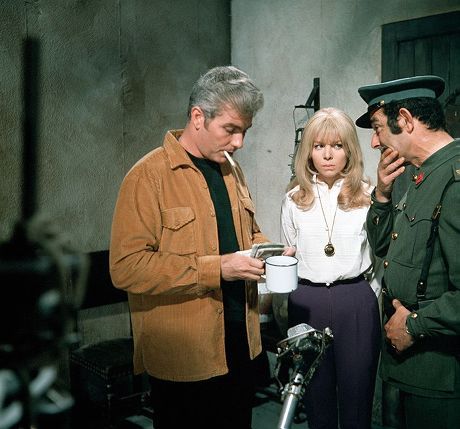



Man in a Suitcase: Night Flight to Andorra (1.30, ITC, 1968)
"You know we're not in this for kicks by now, don't you?"
"I heard a story about Buck, whoever Buck might be, something about taking me behind the sheds and murdering me."
"Ha. Well, old Buck watches a lot of TV, ma'am."
#man in a suitcase#night flight to andorra#classic tv#1968#reed de rouen#jan read#freddie francis#richard bradford#peter woodthorpe#zia mohyeddin#luanshya greer#ewan hooper#edward underdown#carlos pierre#robert crewdson#peter swanwick#fred beauman#ricardo montez#charles laurence#nita lorraine#and so McGill bows out. this was probably never intended as a series finale (it was 28th in production‚ with 1.26 The Revolutionaries the#final episode shot) but it inadvertently acts as a kind of unofficial coda on the series; McGill is finally back doing the work he was#trained for‚ albeit in an unofficial capacity‚ putting together a team for a heist on behalf of the uk government. much of the exposition#is handwaved through (we never really know how McGill came to be doing this job‚ nor why he's explicitly working for the uk when the US are#also a concerned party) but there's much to enjoy in the classic heist setup of a band of uneasy allies working to their own agendas. of#these‚ the late Mohyeddin is the standout as the sole likeable member of the gang; so charming in fact that even when he pulls a knife on#an innocent girl‚ he manages to do it in such a way that he still seems perfectly reasonable and friendly. de Rouen had cowritten the only#real dud in the series‚ 1.22‚ but this is a much better script (and he bagged himself a supporting role into the bargain). Woodthorpe was a#theatre legend‚ having originated parts in both Waiting for Godot and The Caretaker‚ but he was also an infrequent supporting actor in#brit horror films and had already worked with director Francis on three pictures (inc the excellent The Skull for Amicus)
3 notes
·
View notes
Text
So, I finally bit the bullet and watched Chasing Amy. It did not disappoint, by which I mean, oh my fucking goodness, poor fucking Alyssa, are you kidding me? I have never seen a bi woman get treated so horrendously on film, before. Every second of the film I just wanted to hold her, because literally every one and their dog was treating her and talking about her like she was garbage.
And listen, this is not to say I hated it. No, I actually liked it a lot, and I really appreciate the issues it raised. Sexual and racial stereotyping, internalised homophobia, biphobia, infighting in the LGBT community. My issue was that while these things were raised, they weren’t explored very deeply, in favour of Holden’s internal struggle. It’s understandable, because the story was based on Kevin Smith’s relationship with Joey Lauren Adams and his internal struggle during. It stands to reason that this was what he could handle best, rather than really tackle subjects he only knew a scant amount about. As I understand, Kevin has stated that the film probably should have been directed by a lesbian woman. I think if that was the case, it may have been a completely different film. As it stands, I appreciate his efforts, but frustrated at how much was left unexplored.
But, oh my gosh, Joey Lauren Adams. What a fucking powerhouse. Alyssa may well be one of the most charming and lovable characters in any film, which is why it just hurt so much to see her suffer. Even Jay and Silent Bob couldn’t really lift my spirits after seeing her cry like that, though they comforted me a little. I know it was sort of the point that there was no solid conclusion, or happy ending. I respect that, it felt much more realistic. But, I felt like we never got to see Alyssa be really happy, due to the aforementioned everyone-dumping-on-Alyssa theme. I am so, so glad, that the Jay and Silent Bob Reboot has Amy and Holden reconnected as close friends. Honestly, that’s what they felt like to me, the whole time. Not because of the performances, or because I didn’t by Alyssa as bi. Holden and Alyssa honestly just have fantastic platonic chemistry, but not so much romantic chemistry, to me.
I know that Holden is a reasonably popular character, probably not as popular as Banky, but I just did not like him. I commend Kevin Smith for his honesty when he said Holden is the character most based on him, because Holden is horribly unlikeable. If he wasn’t being boring, he was being a dick. But then again, at least the film acknowledges that he’s a dick. I dare even say he was supposed to be. And Banky made me yearn so hard for Brodie. I just wanted Brodie back so often in this film. At least Banky got a couple of redeeming scenes, when he was laughing with Alyssa at the club and when he was signing comics at the end.
As it stands, the characters I liked best were Alyssa, Jay and Silent Bob of course, and Hooper X, who made me laugh most out of everyone. If we got a film of Hooper and Banky as a couple, I think I would be pretty happy.
Also, can we bring my two suffering girls Veronica and Alyssa together for a film where they just have a nice fucking day. Maybe get some ice cream and cuddle, or something, oh my gosh.
#view askewniverse#chasing amy#alyssa jones#holden mcneil#banky edwards#hooper x#jay and silent bob#jay derris#silent bob#bisexual#bisexuality#biphobia
0 notes
Text
YouTube and Patreon Announcement!
Special YouTube and Patreon announcement at Oh God Why?! Nostalgia Reviews! New videos posted today, subscribe and become a Patron for more fun content in the future!
Hey there, friends! Today is an exciting day – I’ve just launched both my completely revamped Patreon page, AND a brand-new YouTube channel! There’s some fun free content right now, including a blooper reel that practically made itself while I was filming my Patreon Intro and Welcome video, and the first video in a series I’m calling “Reading Reviews”, where I find and read funny Amazon,…
View On WordPress
#bloopers and outtakes#clancy brown#edward furlong#funny reviews#general admin stuff#horror#janice harrell#jo gibson#my bloody valentine#patreon#pet sematary 2#reading reviews#reviews#robert englund#slay bells#ted levine#the mangler#the murder game#tobe hooper#youtube#youtube videos
0 notes
Text
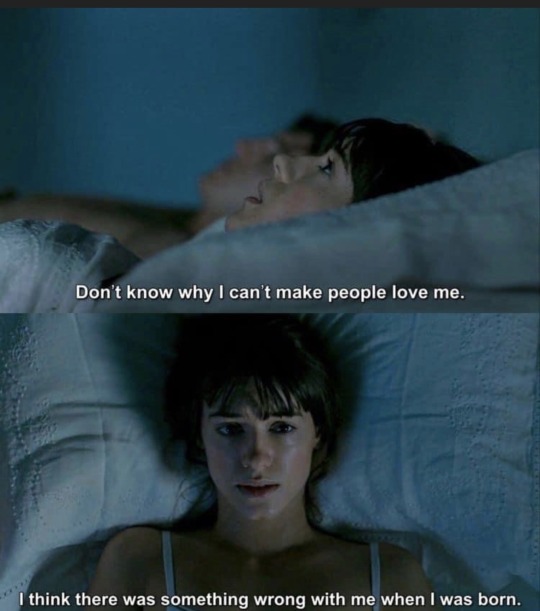
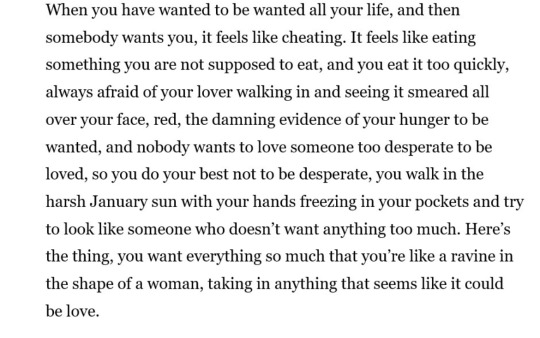
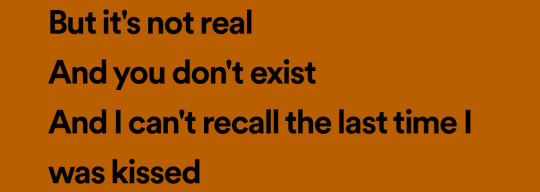
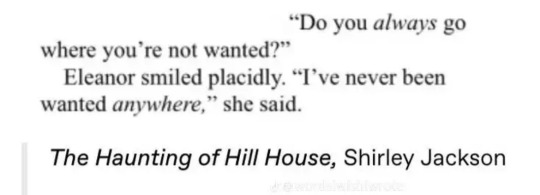



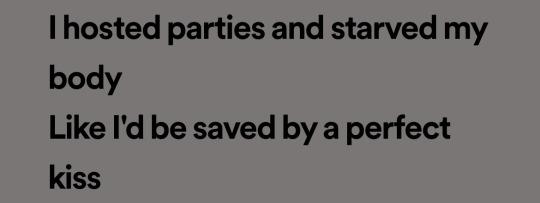









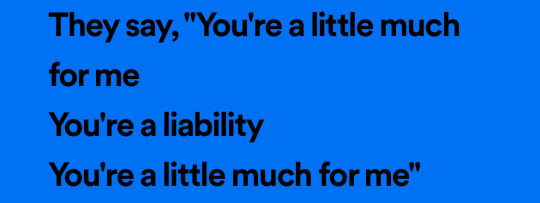


you’re on your own, kid, you always have been
normal people, 2020/@ryebreadgf /ceilings - lizzy mcalpine/the haunting of hill house, shirley jackson/untitled, frank wright/unknown, from pinterest/nicolas martin, “dedicated to light”/you’re on your own, kid - taylor swift/edward hooper, “gayle on the f train”/@seashellronan/tolerate it - taylor swift/unknown/tv - billie eilish/unknown, from pinterest/@lustloveandliarsx/@finehoney/@farmlesbians/liability - lorde/i get so jealous of euthanized dogs - june gehringer/anne magill/you’re on your own, kid - taylor swift
#lilly talks#web weaving#web weaves#webweaving#poetry#parallels#poetry parallels#prose#qoutes#female rage#girlblogger#girlblogging#Books#book qoute#lizzy mcalpine#taylor swift#Art#billie eilish#lonely thoughts#lonely girl#darkness#lonelyness#Text post#compilation#Lilly’s weaves
581 notes
·
View notes
Text
world’s first (televised) excommunicated filmbro
#this is exactly what went down when i was excommunicated from filmbro society#it’s not because i watch cinematic films for homoerotic themes and babygirlism#reverend elijah hooper is the ultimate filmbro ok#sandy bullock reminds me of how i call him ed norty#ok i need to shut up someone get me my muzzle#edward norton#the simpson’s#the blind side#fight club#the red dragon#post!
22 notes
·
View notes
Text
Why People Are Wrong About the Puritans of the English Civil War and New England
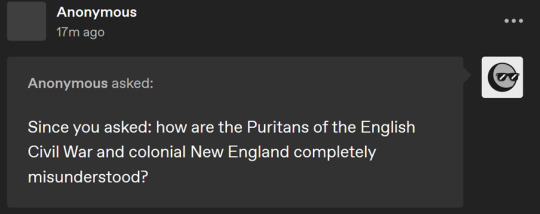



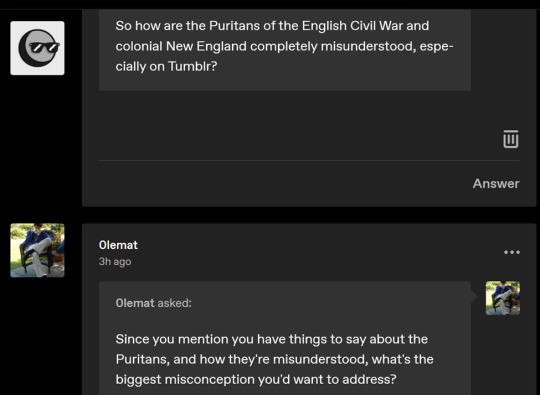
Oh well, if you all insist, I suppose I can write something.
(oh good, my subtle scheme is working...)
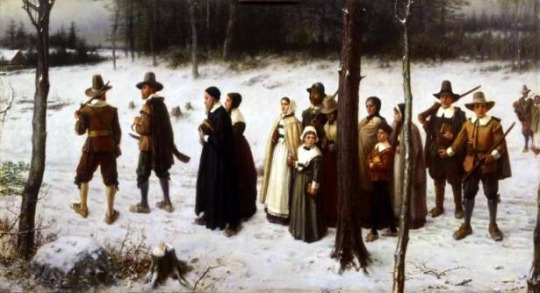
Introduction:
So the Puritans of the English Civil War is something I studied in graduate school and found endlessly fascinating in its rich cultural complexity, but it's also a subject that is popularly wildly misunderstood because it's caught in the jaws of a pair of distorted propagandistic images.
On the one hand, because the Puritans settled colonial New England, since the late 19th century they've been wrapped up with this nationalist narrative of American exceptionalism (that provides a handy excuse for schoolteachers to avoid talking about colonial Virginia and the centrality of slavery to the origins of the United States). If you went to public school in the United States, you're familiar with the old story: the United States was founded by a people fleeing religious persecution and seeking their freedom, who founded a society based on social contracts and the idea that in the New World they were building a city on a hill blah blah America is an exceptional and perfect country that's meant to be an example to the world, and in more conservative areas the whole idea that America was founded as an explicitly Christian country and society.
Then on the other hand, you have (and this is the kind of thing that you see a lot of on Tumblr) what I call the Matt Damon-in-Good-Will-Hunting, "I just read Zinn's People's History of the United States in U.S History 101 and I'm home for my first Thanksgiving since I left for colleg and I'm going to share My Opinions with Uncle Burt" approach. In this version, everything in the above nationalist narrative is revealed as a hideous lie: the Puritans are the source of everything wrong with American society, a bunch of evangelical fanatics who came to New England because they wanted to build a theocracy where they could oppress all other religions and they're the reason that abortion-banning, homophobic and transphobic evangelical Christians are running the country, they were all dour killjoys who were all hopelessly sexually repressed freaks who hated women, and the Salem Witch Trials were a thing, right?
And if anyone spares a thought to examine the role that Puritans played in the English Civil War, it basically short-hands to Oliver Cromwell is history's greatest monster, and didn't they ban Christmas?
Here's the thing, though: as I hope I've gotten across in my posts about Jan Hus, John Knox, and John Calvin, the era of the Reformation and the Wars of Religion that convulsed the Early Modern period were a time of very big personalities who were complicated and not very easy for modern audiences to understand, because of the somewhat oblique way that Early Modern people interpreted and really believed in the cultural politics of religious symbolism.
So what I want to do with this post is to bust a few myths and tease out some of the complications behind the actual history of the Puritans.
Did the Puritans Experience Religious Persecution?
Yes, but that wasn't the reason they came to New England, or at the very least the two periods were divided by some decades. To start at the beginning, Puritans were pretty much just straightforward Calvinists who wanted the Church of England to be a Calvinist Church. This was a fairly mainstream position within the Anglican Church, but the "hotter sort of Protestant" who started to organize into active groups during the reigns of Elizabeth and James I were particularly sensitive to religious symbolism they (like the Hussites) felt smacked of Catholicism and especially the idea of a hierarchy where clergy were a better class of person than the laity.
So for example, Puritans really first start to emerge during the Vestments Controversy in the reign of Edward VI where Bishop Hooper got very mad that Anglican priests were wearing the cope and surplice, which he thought were Catholic ritual garments that sought to enhance priestly status and that went against the simplicity of the early Christian Church. Likewise, during the run-up to the English Civil War, the Puritans were extremely sensitive to the installation of altar rails which separated the congregation from the altar - they considered this to be once again a veneration of the clergy, but also a symbolic affirmation of the Catholic doctrine of transubstantiation.
At the same time, they were not the only religious faction within the Anglican Church - and this is where the religious persecution thing kicks in, although it should be noted that this was a fairly brief but very emotionally intense period. Archbishop William Laud was a leading High Church Episcopalian who led a faction in the Church that would become known as Laudians, and he was just as intense about his religious views as the Puritans were about his. A favorite of Charles I and a first advocate of absolutist monarchy, Laud was appointed Archbishop of Canturbury in 1630 and acted quickly to impose religious uniformity of Laudian beliefs and practices - ultimately culminating in the disastrous decision to try imposing Episcopalianism on Scotland that set off the Bishop's Wars.
The Puritans were a special target of Laud's wrath: in addition to ordering the clergy to do various things offensive to Puritans that he used as a shibboleth to root out clergy with Puritan sympathies and fire them from their positions in the Church, he established official religious censors who went after Puritan writers like William Prynne for seditious libel and tortured them for their criticisms of his actions, cropping their ears and branding them with the letters SL on their faces. Bringing together the powers of Church and State, Laud used the Court of Star Chamber (a royal criminal court with no system of due process) to go after anyone who he viewed as having Puritan sympathies, imposing sentences of judicial torture along the way.
It was here that the Puritans began to make their first connections to the growing democratic movement in England that was forming in opposition to Charles I, when John Liliburne the founder of the Levellers was targeted by Laud for importing religious texts that criticized Laudianism - Laud had him repeatedly flogged for challenging the constitutionality of the Star Chamber court, and "freeborn John" became a martyr-hero to the Puritans.
When the Long Parliament met in 1640, Puritans were elected in huge numbers, motivated as they were by a combination of resistance to the absolutist monarchism of Charles I and the religious policies of Archbishop Laud - who Parliament was able to impeach and imprison in the Tower of the London in 1641.
This relatively brief period of official persecution that powerfully shaped the Puritan mindset was nevertheless disconnected from the phenomena of migration to New England - which had started a decade before Laud became Archbishop of Canterbury and continued decades after his impeachment.
The Puritans Just Wanted to Oppress Everyone Else's Religion:
This is the very short-hand Howard Zinn-esque critique we often see of the Puritan project in the discourse, and while there is a grain of truth to it - in the Massachusetts Bay Colony, the Congregational Church was the official state religion, no other church could be established without permission from the Congregational Church, all residents were required to pay taxes to support the Congregational Church, and only Puritans could vote. Moreover, there were several infamous incidents where the Puritan establishment put Anne Hutchinson on trial and banished her, expelled Roger Williams, and hanged Quakers.
Here's the thing, though: during the Early Modern period, every single side of every single religious conflict wanted to establish religious uniformity and oppress the heretics: the Catholics did it to the Protestants where they could mobilize the power of the Holy Roman Emperor against the Protestant Princes, the Protestants did it right back to the Catholics when Gustavus Adolphus' armies rolled through town, the Lutherans and the Catholics did it to the Calvinists, and everybody did it to the Anabaptists.
That New England was founded as a Calvinist colony is pretty unremarkable, in the final analysis. (By the by, both Hutchinson and Williams were devout if schismatic Puritans who were firmly of the belief that the Anglican Church was a false church.) What's more interesting is how quickly the whole religious project broke down and evolved into something completely different.
Essentially, New England became a bunch of little religious communes that were all tax-funded, which is even more the case because the Congregationalist Church was a "gathered church" where the full members of the Church (who were the only people allowed to vote on matters involving the church, and were the only ones who were allowed to be given baptism and Communion, which had all kinds of knock-on effects on important social practices like marriages and burials) and were made up of people who had experienced a conversion where they can gained an assurance of salvation that they were definitely of the Elect. You became a full member by publicly sharing your story of conversion (which had a certain cultural schema of steps that were supposed to be followed) and having the other full members accept it as genuine.
This is a system that works really well to bind together a bunch of people living in a commune in the wilderness into a tight-knit community, but it broke down almost immediately in the next generation, leading to a crisis called the Half-Way Covenant.
The problem was that the second generation of Puritans - all men and women who had been baptized and raised in the Congrgeationalist Church - weren't becoming converted. Either they never had the religious awakening that their parents had had, or their narratives weren't accepted as genuine by the first generation of commune members. This meant that they couldn't hold church office or vote, and more crucially it meant that they couldn't receive the sacrament or have their own children baptized.
This seemed to suggest that, within a generation, the Congregationalist Church would essentially define itself into non-existence and between the 1640s and 1650s leading ministers recommended that each congregation (which was supposed to decide on policy questions on a local basis, remember) adopt a policy whereby the children of baptized but unconverted members could be baptized as long as they did a ceremony where they affirmed the church covenant. This proved hugely controversial and ministers and laypeople alike started publishing pamphlets, and voting in opposing directions, and un-electing ministers who decided in the wrong direction, and ultimately it kind of broke the authority of the Congregationalist Church and led to its eventual dis-establishment.
The Puritans are the Reason America is So Evangelical:
This is another area where there's a grain of truth, but ultimately the real history is way more complicated.
Almost immediately from the founding of the colony, the Puritans begin to undergo mutation from their European counterparts - to begin with, while English Puritans were Calvinists and thus believed in a Presbyterian form of church government (indeed, a faction of Puritans during the English Civil War would attempt to impose a Presbyterian Church on England.), New England Puritans almost immediately adopted a congregationalist system where each town's faithful would sign a local religious constitution, elect their own ministers, and decide on local governance issues at town meetings.
Essentially, New England became a bunch of little religious communes that were all tax-funded, which is even more the case because the Congregationalist Church was a "gathered church" where the full members of the Church (who were the only people allowed to vote on matters involving the church, and were the only ones who were allowed to be given baptism and Communion, which had all kinds of knock-on effects on important social practices like marriages and burials) and were made up of people who had experienced a conversion where they can gained an assurance of salvation that they were definitely of the Elect. You became a full member by publicly sharing your story of conversion (which had a certain cultural schema of steps that were supposed to be followed) and having the other full members accept it as genuine.
This is a system that works really well to bind together a bunch of people living in a commune in the wilderness into a tight-knit community, but it broke down almost immediately in the next generation, leading to a crisis called the Half-Way Covenant.
The problem was that the second generation of Puritans - all men and women who had been baptized and raised in the Congrgeationalist Church - weren't becoming converted. Either they never had the religious awakening that their parents had had, or their narratives weren't accepted as genuine by the first generation of commune members. This meant that they couldn't hold church office or vote, and more crucially it meant that they couldn't receive the sacrament or have their own children baptized.
This seemed to suggest that, within a generation, the Congregationalist Church would essentially define itself into non-existence and between the 1640s and 1650s leading ministers recommended that each congregation (which was supposed to decide on policy questions on a local basis, remember) adopt a policy whereby the children of baptized but unconverted members could be baptized as long as they did a ceremony where they affirmed the church covenant. This proved hugely controversial and ministers and laypeople alike started publishing pamphlets, and voting in opposing directions, and un-electing ministers who decided in the wrong direction, and accusing one another of being witches. (More on that in a bit.)
And then the Great Awakening - which to be fair, was a major evangelical effort by the Puritan Congregationalist Church, so it's not like there's no link between evangelical - which was supposed to promote Congregational piety ended up dividing the Church and pretty soon the Congregationalist Church is dis-established and it's safe to be a Quaker or even a Catholic on the streets of Boston.
But here's the thing - if we look at which denominations in the United States can draw a direct line from themselves to the Congregationalist Church of the Puritans, it's the modern Congregationalists who are entirely mainstream Protestants whose churches are pretty solidly liberal in their politics, the United Church of Christ which is extremely cultural liberal, and it's the Unitarian Universalists who are practically issued DSA memberships. (I say this with love as a fellow comrade.)
By contrast, modern evangelical Christianity (although there's a complicated distinction between evangelical and fundamentalist that I don't have time to get into) in the United States is made up of an entirely different set of denominations - here, we're talking Baptists, Pentacostalists, Methodists, non-denominational churches, and sometimes Presbyterians.
The Puritans Were Dour Killjoys Who Hated Sex:
This one owes a lot to Nathaniel Hawthorne's Scarlet Letter.
The reality is actually the opposite - for their time, the Puritans were a bunch of weird hippies. At a time when most major religious institutions tended to emphasize the sinful nature of sex and Catholicism in particular tended to emphasize the moral superiority of virginity, the Puritans stressed that sexual pleasure was a gift from God, that married couples had an obligation to not just have children but to get each other off, and both men and women could be taken to court and fined for failing to fulfill their maritial obligations.
The Puritans also didn't have much of a problem with pre-marital sex. As long as there was an absolute agreement that you were going to get married if and when someone ended up pregnant, Puritan elders were perfectly happy to let young people be young people. Indeed, despite the objection of Jonathan Edwards and others there was an (oddly similar to modern Scandinavian customs) old New England custom of "bundling," whereby a young couple would be put into bed together by their parents with a sack or bundle tied between them as a putative modesty shield, but where everyone involved knew that the young couple would remove the bundle as soon as the lights were turned out.
One of my favorite little social circumlocutions is that there was a custom of pretending that a child clearly born out of wedlock was actually just born prematurely to a bride who was clearly nine months along, leading to a rash of surprisingly large and healthy premature births being recorded in the diary of Puritan midwife Martha Ballard. Historians have even applied statistical modeling to show that about 30-40% of births in colonial America were pre-mature.
But what about non-sexual dourness? Well, here we have to understand that, while they were concerned about public morality, the Puritans were simultaneously very strict when it came to matters of religion and otherwise normal people who liked having fun. So if you go down the long list of things that Puritans banned that has landed them with a reputation as a bunch of killjoys, they usually hide some sort of religious motivation.
So for example, let's take the Puritan iconoclastic tendency to smash stained glass windows, whitewash church walls, and smash church organs during the English Civil War - all of these things have to do with a rejection of Catholicism, and in the case of church organs a belief that the only kind of music that should be allowed in church is the congregation singing psalms as an expression of social equality. At the same time, Puritans enjoyed art in a secular context and often had portraits of themselves made and paintings hung on their walls, and they owned musical instruments in their homes.
What about the wearing nothing but black clothing? See, in our time wearing nothing but black is considered rather staid (or Goth), but in the Early Modern period the dyes that were needed to produce pure black cloth were incredibly expensive - so wearing all black was a sign of status and wealth, hence why the Hapsburgs started emphasizing wearing all-black in the same period. However, your ordinary Puritan couldn't afford an all-black attire and would have worn quite colorful (but much cheaper) browns and blues and greens.
What about booze and gambling and sports and the theater and other sinful pursuits? Well, the Puritans were mostly ok with booze - every New England village had its tavern - but they did regulate how much they could serve, again because they were worried that drunkenness would lead to blasphemy. Likewise, the Puritans were mostly ok with gambling, and they didn't mind people playing sports - except that they went absolutely beserk about drinking, gambling, and sports if they happened on the Sabbath because the Puritans really cared about the Sabbath and Charles I had a habit of poking them about that issue. They were against the theater because of its association with prostitution and cross-dressing, though, I can't deny that. On the other hand, the Puritans were also morally opposed to bloodsports like bear-baiting, cock-fighting, and bare-knuckle boxing because of the violence it did to God's creatures, which I guess makes them some of the first animal rights activsts?
They Banned Christmas:
Again, this comes down to a religious thing, not a hatred of presents and trees - keep in mind that the whole presents-and-trees paradigm of Christmas didn't really exist until the 19th century and Dickens' Christmas Carol, so what we're really talking about here is a conflict over religious holidays - so what people were complaining about was not going to church an extra day in the year. I don't get it, personally.
See, the thing is that Puritans were known for being extremely close Bible readers, and one of the things that you discover almost immediately if you even cursorily read the New Testament is that Christ was clearly not born on December 25th. Which meant that the whole December 25th thing was a false religious holiday, which is why they banned it.
The Puritans Were Democrats:
One thing that I don't think Puritans get enough credit for is that, at a time when pretty much the whole of European society was some form of monarchist, the Puritans were some of the few people out there who really committed themselves to democratic principles.
As I've already said, this process starts when John Liliburne, an activist and pamphleteer who promoted the concept of universal human rights (what he called "freeborn rights"), took up the anti-Laudian cause and it continued through the mobilization of large numbers of Puritans to campaign for election to the Long Parliament.
There, not only did the Puritans vote to revenge themselves on their old enemy William Laud, but they also took part in a gradual process of Parliamentary radicalization, starting with the impeachment of Strafford as the architect of arbitrary rule, the passage of the Triennal Acts, the re-statement that non-Parliamentary taxation was illegal, the Grand Remonstrance, and the Militia Ordinance.
Then over the course of the war, Puritans served with distinction in the Parliamentary army, especially and disproportionately in the New Model Army where they beat the living hell out of the aristocratic armies of Charles I, while defying both the expectations and active interference of the House of Lords.
At this point, I should mention that during this period the Puritans divided into two main factions - Presbyterians, who developed a close political and religious alliance with the Scottish Covenanters who had secured the Presbyterian Church in Scotland during the Bishops' Wars and who were quite interested in extending an established Presbyterian Church; and Independents, who advocated local congregationalism (sound familiar) and opposed the concept of established churches.
Finally, we have the coming together of the Independents of the New Model Army and the Leveller movement - during the war, John Liliburne had served with bravery and distinction at Edgehill and Marston Moore, and personally capturing Tickhill Castle without firing a shot. His fellow Leveller Thomas Rainsborough proved a decisive cavalry commander at Naseby, Leicester, the Western Campaign, and Langport, a gifted siege commander at Bridgwater, Bristol, Berkeley Castle, Oxford, and Worcester.
Thus, when it came time to hold the Putney Debates, the Independent/Leveller bloc had both credibility within the New Model Army and the only political program out there. Their proposal:
redistricting of Parliament on the basis of equal population; i.e one man, one vote.
the election of a Parliament every two years.
freedom of conscience.
equality under the law.
In the context of the 17th century, this was dangerously radical stuff and it prompted Cromwell and Fairfax into paroxyms of fear that the propertied were in danger of being swamped by democratic enthusiasm - leading to the imprisonment of Lilburne and the other Leveller leaders and ultimately the violent suppression of the Leveller rank-and-file.
As for Cromwell, well - even the Quakers produced Richard Nixon.
#history#puritans#calvinism#english civil war#oliver cromwell#the stupid meme about christmas#new england#protestantism
422 notes
·
View notes
